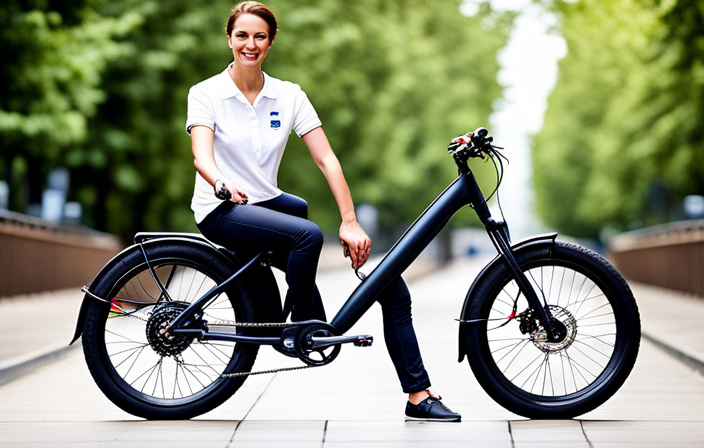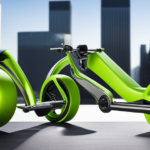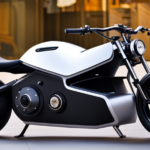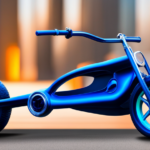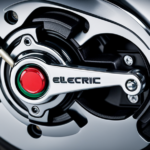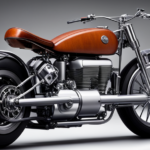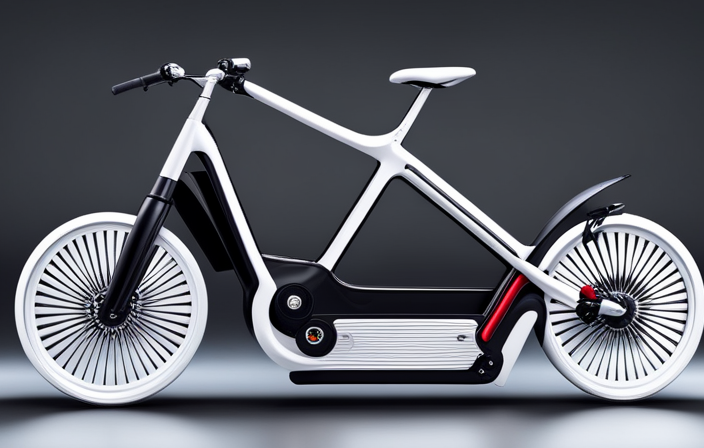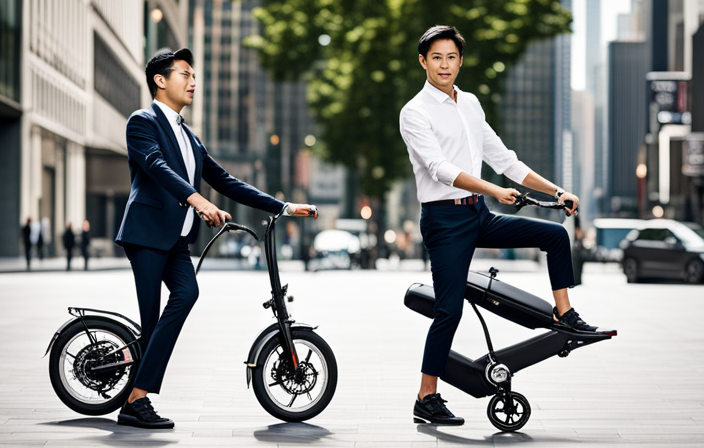Riding the open road on a Coleman mini bike is a thrilling experience, but what if you could take it to the next level? Imagine effortlessly gliding along, powered by electricity, with zero emissions and a silent motor.
In this article, I will guide you through the process of converting your Coleman mini bike into an electric-powered machine. From assessing the feasibility to selecting the right components, we’ll cover everything you need to know to transform your mini bike into a green, high-performance ride.
Key Takeaways
- The conversion process involves removing the engine and fuel system, installing an electric motor and controller, connecting the battery and wiring, and testing under different loads and speeds.
- It is important to regularly inspect and maintain the bike, follow manufacturer’s guidelines for charging and maintenance, and keep the battery clean and free from dirt and debris.
- Upgrading the battery, motor, and controller can enhance longevity and performance, while optimizing aerodynamics can reduce air resistance.
- Safety considerations include following safety guidelines, using protective gear while riding, and consulting professionals for technical expertise. Enjoy the extended range, smooth acceleration, and better control of the electric mini bike.
Assessing the Feasibility of Conversion
You’ll need to determine if converting your Coleman mini bike to electric is possible.
First, conduct a cost analysis to evaluate the financial feasibility of the conversion. Consider the cost of the electric motor, batteries, charger, and any additional components required for the conversion. Compare this with the cost of a new electric mini bike to determine if the conversion is worth the investment.
Next, assess the environmental impact of the conversion. Electric bikes produce zero emissions, making them more eco-friendly compared to gas-powered bikes. Additionally, consider the long-term savings on fuel costs and reduced carbon footprint.
However, keep in mind that the conversion process may require modifications to the bike’s frame and may affect its overall performance. Therefore, it is important to weigh the costs and benefits before proceeding with the conversion.
Choosing the Right Electric Motor
When selecting the appropriate electric motor, it’s essential to consider factors such as power output and compatibility.
Electric motor selection for converting a Coleman mini bike involves evaluating the motor power requirements and matching them to the desired performance.
To begin, determine the power needed for the bike based on its weight, desired top speed, and terrain it will be used on. This will determine the minimum power output required for the motor.
Additionally, consider the voltage and current requirements of the motor and ensure it is compatible with the available battery pack.
It’s important to choose a motor that can handle the demands of the bike while providing sufficient power for a smooth and efficient ride.
By carefully assessing these factors, you can select the right electric motor for your Coleman mini bike conversion.
Selecting the Appropriate Battery System
To choose the right battery system, it’s important to consider factors such as voltage and capacity requirements. When converting a Coleman mini bike to electric, selecting the appropriate battery capacity is crucial. The capacity of the battery determines how much energy it can store, which in turn affects the range and duration of the bike’s operation. It is essential to calculate the power consumption of the electric motor and other components to determine the required battery capacity.
Additionally, selecting the right battery chemistry is vital. Different battery chemistries have varying energy densities, cycle life, and charging characteristics. Lithium-ion batteries are commonly used for electric vehicle applications due to their high energy density, longer cycle life, and faster charging capabilities.
When choosing the battery system, carefully consider the required capacity and the appropriate battery chemistry for optimal performance and efficiency.
-
Factors to consider when choosing battery capacity:
-
Power consumption of the electric motor and other components
-
Desired range and duration of operation
-
Factors to consider when selecting battery chemistry:
-
Energy density
-
Cycle life
-
Charging characteristics
Modifying the Frame and Suspension
Modifying the frame and suspension is a crucial step in transforming the Coleman mini bike into an electric vehicle. To ensure a successful conversion, several modifications need to be made. First, the seat and handlebars should be adjusted to provide a comfortable riding position for the electric mini bike. This can be done by replacing the existing seat and handlebars with ones that are suitable for an electric vehicle.
Next, enhancing the suspension system is essential for a smooth and controlled ride. Upgrading the suspension components, such as the shocks and springs, can help improve the bike’s stability and handling. Additionally, reinforcing the frame may be necessary to accommodate the added weight of the electric components. This can be done by adding additional support or using stronger materials.
By making these modifications, the Coleman mini bike can be transformed into an electric vehicle that offers a comfortable and enjoyable riding experience.
| Modification | Description | Benefits |
|---|---|---|
| Adjusting seat and handlebars | Replacing existing seat and handlebars for a comfortable riding position | Improved rider comfort |
| Enhancing suspension system | Upgrading shocks and springs for better stability and handling | Smooth and controlled ride |
| Reinforcing the frame | Adding support or using stronger materials to accommodate added weight | Increased durability |
Rewiring and Installing the Electrical Components
Once you have completed the modifications to the frame and suspension, you can now move on to rewiring and installing the electrical components for your electric vehicle.
The first step in this process is installing the controller, which is responsible for regulating the power flow from the battery to the motor. Begin by locating a suitable spot on the frame to mount the controller securely. Once mounted, connect the positive and negative wires from the battery to the corresponding terminals on the controller.
Next, you will need to wire the throttle, which controls the speed of the electric bike. Connect the throttle wires to the appropriate terminals on the controller, ensuring a secure connection.
Finally, double-check all the connections and secure any loose wires with zip ties.
With the electrical components properly installed and wired, your Coleman mini bike will be ready to run on electric power.
Upgrading the Brakes and Wheels for Safety
After rewiring and installing the electrical components, it’s time to focus on upgrading the brakes and wheels for safety and performance enhancements. When it comes to upgrading the brakes, safety considerations should be the top priority. The original brakes on a Coleman mini bike may not be designed to handle the increased speed and power of an electric motor. Upgrading to a more robust braking system, such as hydraulic disc brakes, can provide better stopping power and control. Additionally, choosing the right wheels is crucial for maximizing performance. Upgrading to larger diameter wheels with off-road tires can improve stability and traction, especially when riding on rough terrain. It is important to ensure that the wheels are compatible with the mini bike’s frame and axle size for a proper fit. By upgrading the brakes and wheels, you can enhance both the safety and performance of your converted electric Coleman mini bike.
| Safety Considerations | Choosing the Right Wheels | Performance Enhancements |
|---|---|---|
| Upgrade to robust braking system | Choose larger diameter wheels | Improved stopping power and control |
| Ensure compatibility with mini bike’s frame and axle size | Opt for off-road tires | Enhanced stability and traction |
| Better handle increased speed and power | Maximize performance on rough terrain | Improved safety and performance |
Testing and Troubleshooting the Conversion
To ensure a successful conversion, it’s important to thoroughly test and troubleshoot the modified components. Here are four key steps to troubleshoot issues and optimize performance:
-
Test the electrical system: Check all connections, wiring, and components to ensure they’re properly connected and functioning. Use a multimeter to measure voltage and current at different points in the system.
-
Check the motor performance: Make sure the motor is running smoothly and providing sufficient power. Test it under different loads and speeds to identify any issues or abnormalities.
-
Evaluate battery performance: Monitor the battery voltage and capacity to ensure it’s delivering the required power consistently. Check for any signs of overheating or excessive discharge.
-
Review controller settings: Adjust the controller parameters to optimize the performance of the electric mini bike. Fine-tune the throttle response, braking regen, and other settings to achieve the desired balance between speed and efficiency.
By following these testing and troubleshooting steps, you can identify and address any issues in the conversion process, ensuring a safe and efficient electric mini bike.
Ensuring Proper Charging and Maintenance
Make sure you properly charge and maintain your electric mini bike to ensure its longevity and optimal performance.
When it comes to charging issues, it’s important to follow the manufacturer’s guidelines for charging time and voltage. Overcharging can lead to battery damage, while undercharging can result in reduced range and power.
Regularly inspect the charging cable and connectors for any signs of wear or damage, as these can affect the charging process. Additionally, keep the battery clean and free from dirt and debris, as this can cause overheating.
As for maintenance tips, regularly check the tire pressure and adjust it as needed for smooth and efficient rides. Lubricate the chain and other moving parts to prevent wear and ensure smooth operation.
Lastly, keep an eye on the battery health and consider replacing it when necessary to maintain optimal performance.
Adapting the Mini Bike for Longevity and Performance
To ensure longevity and optimal performance, you should consider making adjustments to your electric mini bike. Adapting the mini bike for increased range, improving the mini bike’s speed, and acceleration can greatly enhance your riding experience. Here are some modifications you can make:
| Modification | Purpose | Benefits |
|---|---|---|
| Upgrade the battery | Increase range | Longer rides without recharging |
| Install a high-performance motor | Improve speed and acceleration | Quicker acceleration and higher top speed |
| Optimize aerodynamics | Reduce air resistance | Improved efficiency and increased range |
| Upgrade the controller | Enhance power delivery | Smoother acceleration and better control |
By incorporating these modifications, you can transform your electric mini bike into a high-performing machine. However, it’s important to note that making these adjustments may void any warranties and could require technical expertise. Therefore, it’s advisable to consult with professionals or experienced enthusiasts before making any modifications. With the right adaptations, you can enjoy extended range and thrilling speed on your electric mini bike.
Enjoying Your Electric-Powered Coleman Mini Bike
Get ready to have a blast riding your electrified Coleman mini bike.
When it comes to electric motor options for your mini bike, there are a few choices to consider. You can opt for a brushless DC motor, which offers higher efficiency and longer lifespan. Another option is a brushed DC motor, which is more affordable but may require more maintenance. It’s important to choose a motor that suits your riding needs and preferences.
As for battery capacity, it’s crucial to select a battery that provides enough power for your desired ride duration. Consider factors like voltage, amp-hour rating, and weight when choosing a battery. The higher the voltage and amp-hour rating, the longer you can ride before needing to recharge.
So, before hitting the trails, make sure you have the right electric motor and battery capacity for an electrifying ride.
Frequently Asked Questions
How long does it typically take to convert a Coleman mini bike to electric?
Converting a Coleman mini bike to electric usually takes several hours to a few days, depending on the complexity and experience. Common challenges include finding suitable components, ensuring proper wiring, and overcoming compatibility issues.
Can I still pedal the mini bike if I run out of battery power?
If the battery runs out, you can still pedal the mini bike. However, the pedaling will be more difficult due to the added weight of the electric components. The benefits of electric conversion include increased speed and range.
Are there any legal requirements or restrictions for converting a mini bike to electric?
There are legal requirements and restrictions for converting a mini bike to electric. Safety precautions must be taken during the conversion process to ensure the bike meets safety standards. Additionally, converting to electric offers environmental benefits such as reduced emissions and noise pollution.
Can I use any type of electric motor for the conversion, or are there specific requirements?
I investigated the truth of electric motor requirements. There are specific requirements for converting a mini bike to electric. It is important to choose an electric motor that meets the power and speed requirements of the bike. The advantages of electric conversion include increased efficiency and reduced emissions.
How much will the conversion cost in total, including all the necessary components and modifications?
The conversion cost estimation for a mini bike electric conversion depends on various factors such as the type of motor, battery capacity, and additional components. A cost breakdown would include the motor, batteries, controller, wiring, and other necessary modifications.
Conclusion
In conclusion, converting a Coleman mini bike to electric is a complex but rewarding project. By carefully assessing the feasibility, selecting the right components, and making necessary modifications, you can transform your mini bike into a powerful and efficient electric vehicle.
One interesting statistic to note is that electric bikes have been shown to reduce carbon emissions by up to 95% compared to gasoline-powered bikes, making them a more environmentally friendly transportation option.
So, not only will you enjoy the performance and longevity of your electric-powered Coleman mini bike, but you’ll also be contributing to a cleaner and greener future.

